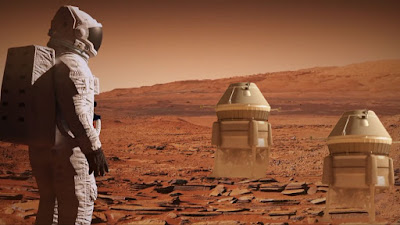The red planet Earth's neighbor and the destination of NASA's most ambitious mission to date but this expedition will be harder than we ever thought possible it hurts to think of how hard it is at the farthest a human being has ever been from the earth, we got to take every precaution as NASA's astronauts arrive at Mars, they'll face a huge obstacle landing on the planet is a daunting task in the past Mars hasn't always rolled out the welcome mat Mars is kind of like a graveyard for spacecraft it's actually really hard to send something from Earth and land it on Mars.
This is how the European Space Agency hoped its $250,000,000 skia Pirelli Lander would touchdown in 2016 but the Landers system's got it wrong the parachute detached early sending the craft into freefall for 33 seconds skia Pirelli smashed into the surface at 335 miles an hour leaving a deep black scar on the Martian landscape it turns out that Mars is actually a particularly difficult planet to land on even humanity's most brilliant engineers we've got about a 50% success rate when it comes to landing on Mars.
The red planet is littered with dead spacecraft that didn't stick the landing and for NASA's first crewed - sent to Mars the space agency must learn from these mistakes but as the crew hurdles toward.
the surface they're battling the same problem as all the Landers that failed before the Martian atmosphere is 100 times thinner than Earth's, so it can't provide the drag needed to slow a spacecraft down, so it's not like the earth where you can have these big giant parachutes that gently glide you down to the surface you can use some of the air, but it's hard the Red Planet's thin atmosphere is a problem that's been billions of years in the making Mars doesn't have a large atmosphere because it's constantly being peeled away due to the lack of protection of a magnetic field the solar wind can strip away an atmosphere on earth a liquid metal core creates a magnetic field which shields the planet and helps maintain the atmosphere.
Mars is different 4.5 billion years ago Mars and Earth formed from dust and gas in space Mars forms we're building materials were scarce its growth was stunted so Mars is much smaller than the earth it's a factor of 10 smaller than the earth and that factor of 10 in mass is important all of that extra mass allows the inside of the earth to stay warm and to have a core that's rotating which generates a magnetic field 4 billion years ago the churning heart of Mars started to cool and solidify with no hot core there's no magnetic field being generated all of the high velocity charge particles coming from the Sun pick away at the atmosphere and slowly tear it away.
We know it's losing atmosphere every second due to the solar wind so you know bye-bye atmosphere, with little Martian atmosphere to work with NASA had to be creative to get it screwless Landers to the Martian surface in 2012 the Revolutionary sky crane landed the Curiosity rover using parachutes and retrorockets previous missions have used both a parachute and something else like a bouncy ball inflated around the spacecraft I don't think a human crew is gonna be too pleased if they're going to be bouncing under the surface and an airbag rolling to a stop right to land people on Mars NASA will need some new tricks the 2020 Rover will overcome the challenge with the advanced supersonic parachute inflation research experiment aspire it will rapidly slow down the craft with the force of an airplane jet engine.
This is fine for the rover it's actually going to work no problem but it's not going to work for people a human Lander will weigh far more than the two thousand three hundred pound Rover not even supersonic parachutes could land two crews safely on Mars NASA will need a new plan one idea is to use the thin Martian atmosphere in a unique way there's an idea of coming in really fast getting to the thick part of the atmosphere and then going horizontal to the ground and gliding and losing your momentum that way.
As the astronauts descend they tilt the nose of the Lander towards the Martian surface aiming for the thickest part of the atmosphere close to the ground then they pull up at the last second using friction from the atmosphere to slow the crowd descent engines switch on for the final touchdown is this a crazy idea I mean yeah it's it's a little bit weird I don't know if we'd really think about it doing something like this but I mean you've got to think outside the box sometimes right now NASA's plans for landing a craft on Mars are still on the drawing board but even if they can get astronauts on to the surface the thin atmosphere isn't done with them yet it causes swirling dust storms that cover the planet's entire surface Mars doesn't just have dust devils it has dust hill and these towering clouds have killed before.
